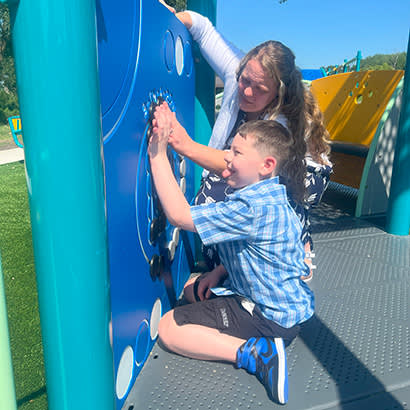
For an enhanced digital experience, read this story in the ezine.
Exciting changes are underway at Ashland Park in Clarksville, Indiana. The Clarksville Parks and Recreation Department has opened a new ADA-accessible playground. Funded by a grant from the Land and Water Conservation Fund and administered by the Indiana Department of Natural Resources, this project marks a significant step forward in creating inclusive play spaces.
The previous playground, installed in 1995, was overdue for replacement. When the opportunity for a new playground arose, we knew inclusivity had to be at the forefront of our design. With nearly $600,000 allocated for the new playground, we also realized we had to replace the old mulch with new surfacing.
Welcoming All
Our primary goal was to eliminate barriers that prevented children with disabilities from fully participating. We incorporated ramps and low entry points so that children who use wheelchairs or other mobility devices could access the playground and enjoy the equipment as much as their peers. Ramps provide smooth transitions to elevated play structures, allowing all children to explore and interact at different heights. Low entry points on swings, slides and interactive panels allow children with limited mobility to engage with these features without undue strain. These adjustments create a welcoming and inclusive environment.
The surface of a playground is another critical factor in accessibility. Traditional surfaces like sand, wood chips or gravel can be difficult for children with mobility aids. I learned about unitary surfaces during our playground planning process. These surfaces, such as poured-in-place rubber, interlocking tiles, and synthetic turf or grass, offer a stable, even surface that is easy for wheelchairs and other mobility devices to navigate. This also reduces the risk of trips and falls, creating a safer environment for all children. Due to budget constraints, we opted for synthetic turf surfacing.
Benefits of Inclusive Play
Inclusive playgrounds extend beyond physical accessibility. When children of all abilities play together, they learn social skills, such as empathy, cooperation and understanding. Inclusive playgrounds foster an environment where differences are celebrated, and children learn to appreciate diversity from a young age. Additionally, inclusive play promotes physical health and mental well-being. Active play aids in physical development, coordination and overall fitness. For children with disabilities, ensuring access to play structures that cater to their needs can significantly improve their quality of life.
Creating an inclusive and ADA-accessible playground benefits the children who use it and the community as a whole. It reflects a commitment to inclusivity and equality, showcasing the community’s dedication to providing for all its residents. These spaces become community hubs where families can gather, socialize and support one another.
Inclusive playgrounds raise awareness about the importance of accessibility, encouraging other public spaces to adopt similar practices. They set a standard for future projects, inspiring a more inclusive approach to community planning and development.
I am proud to be part of a community that values every child’s right to play. Our new playground at Ashland Park is a testament to our commitment to inclusivity and a welcoming space for all.
BJ Nelson Lynton, CPRP, AFO, is Superintendent at Clarksville (Indiana) Parks and Recreation.

